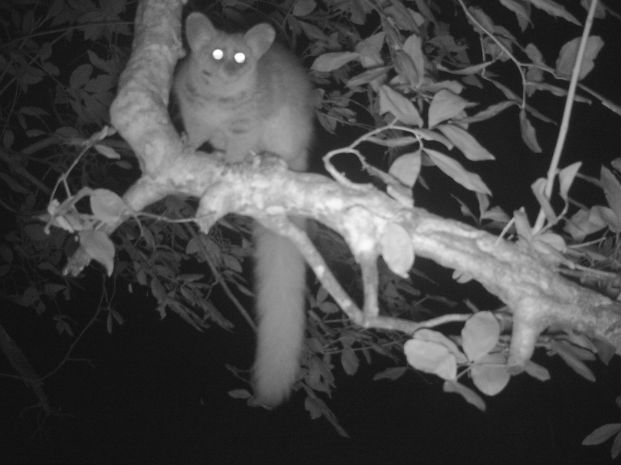
The nocturnal bush baby is the closest living relative of the earliest primates. They can often be spotted in acacia trees at night as their eyes reflect reddish in torch light. The thick-tailed bush baby is much bigger than the lesser bush baby. All bush babies have large bulging eyes which are so big they can’t move in their sockets.
8 facts about the bush baby
1. Urine washing
Bush babies practice “urine-washing”. This is the process by which they urinate into cupped hands before wiping it on their feet. When they climb and jump through the trees they mark their territory.
2. Eye sight
Their eyes are so big that they can not be moved in their sockets. However, because they bulge they can see a full 250 degrees around them (50 degrees more than us). They can also rotate their head a full 180 degrees like an owl.
The Southern Lesser Galago, bush baby, is perfectly adapted to hunt insects at night.
Video length: 1 minute 45 seconds. Video source: Nature on PBS
3. Bush baby grooming
They have comb-like incisors which they use for grooming. Any hair caught in these teeth are removed by using a “second tongue” which is located just below the row of lower teeth.
4. Fighting
Bush babies fight like boxers, they sit on their hind legs and hold up their fists. Juvenile bush babies will hang upside down from branches with their hands and kick one another.
5. Jumping
Thanks to jumping muscles which comprise 10% of their body mass the lesser bush baby can jump 2.25 m upwards from a standing start.
Wildlife film makers catch thes bush babies jumping around there garden in South Africa.
Video length: 3 minutes 58 seconds. Video source: Nature on PBS
6. Bush baby hearing
Bush babies have antenna like ears which allows them to track insects in the dark which they then grab with incredible speed.
7. Adaptations
The delicate bat-like ears of a bush baby can be folded back so that they are not damaged when they leap through thorny acacia trees.
8. Nightly range
The 37 cm long lesser bush baby can cover over 1 km in a night as it leaps from bush to bush with horizontal jumps of as much as 4 m in length.
Bush baby fact video
Galagos, also known as bush babies, or nagapies, are small nocturnal primates native to continental Africa, and make up the family Galagidae.
Video length: 1 minute 46 seconds. Video source: 10 facts
Vote for the fact you find most fascinating
The delicate bat-like ears of a bush baby can be folded back so that they are not damaged when they leap through thorny acacia trees.
The 37 cm long lesser bush baby can cover over 1 km in a night as it leaps from bush to bush with horizontal jumps of as much as 4 m in length.
Bush babies fight like boxers, they sit on their hind legs and hold up their fists. Juvenile bush babies will hang upside down from branches with their hands and kick one another.
Bush babies have comb-like incisors which they use for grooming. Any hair caught in these teeth are removed by using a “second tongue” which is located just below the row of lower teeth.
Thanks to jumping muscles which comprise 10% of their body mass the lesser bush baby can jump 2.25 m upwards from a standing start.
Bush baby eyes are so big that they can not be moved in their sockets. However, because they bulge they can see a full 250 degrees around them (50 degrees more than us). They can also rotate their head a full 180 degrees like an owl.
Bush babies have antenna like ears which allows them to track insects in the dark which they then grab with incredible speed.
Bush babies practice “urine-washing”. This is the process by which they urinate into cupped hands before wiping it on their feet. When they climb and jump through the trees they mark their territory.



